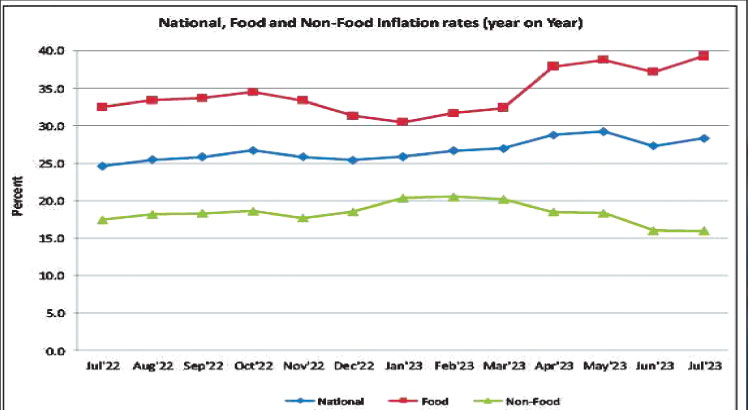Consumers’ buying power declining
Consumers’ buying power continues to fall amid continued pressure on inflation rate which has jumped to 28.4 percent largely due to increased food prices, National Statistical Office (NSO) data shows.
In its July 2023 Consumer Price Indices, NSO said the year-on-year headline inflation rate for July 2023 increased by 1.1 percentage points to 28.4 percent from the 27.3 percent the previous month.
The increase in the prices of goods and services in July 2023 was triggered by a 2.1 percentage points rise in food inflation to 39.3 percent from 37.2 percent the previous month, according to NSO.
However, non-food inflation remained unchanged at 16 percent during the review period.

Speaking in an interview yesterday, Consumers Association of Malawi executive director John Kapito said the rise in maize prices continues to pose challenges, considering the significance of the staple grain in the inflation basket.
As part of the food component, maize accounts for about 53.7 percent of the consumer price index, an aggregate basket of goods and services for computing inflation.
“Rising maize price has created challenges for consumers as we have noted a sharp rise in the cost of living,” said Kapito.
He said this year’s lean period has come early, a situation that creates uncertainty in prices maize.
Economist Bond Mtembezeka said in an interview yesterday the food output situation and the foreign exchange shortages present strong upside risks to inflation.
“Food prices continue to be under pressure and going forward, the situation could be worse,” he said.
The rise in inflation is happening at a time the Integrated Food Security Phase Clarification (IPC) has projected heightened food insecurity pressures, making households with limited financial resources find it challenging to buy food.
The IPC expects the situation to worsen from October 2023 to March 2024, with 4.4 million people or 22 percent of country’s population, worst affected and requiring food aid to sustain their livelihoods and mitigate food consumption gaps.
Reads the report in part: “The maximum projected price for maize is expected to be at K965 per kilogramme [kg] although it may be even higher in some markets.
“The above average prices will likely affect rural and urban households to provide unfavourable financial access to food during the projection period.”
The country is currently grappling with a significant decrease in the output of maize, with output estimated to be six to seven percent lower than last year.
Meanwhile, Femine Early Warning Systems Network price data shows that in July, the average price of maize in all monitored markets ranged from K500 to K615 per kg.






One Comment